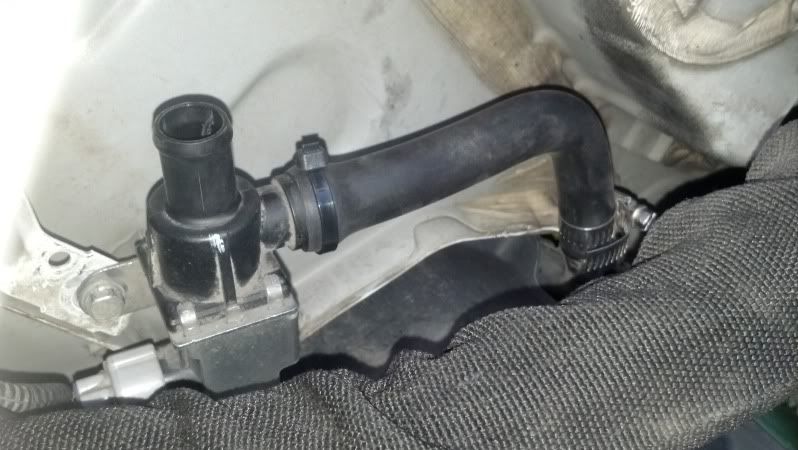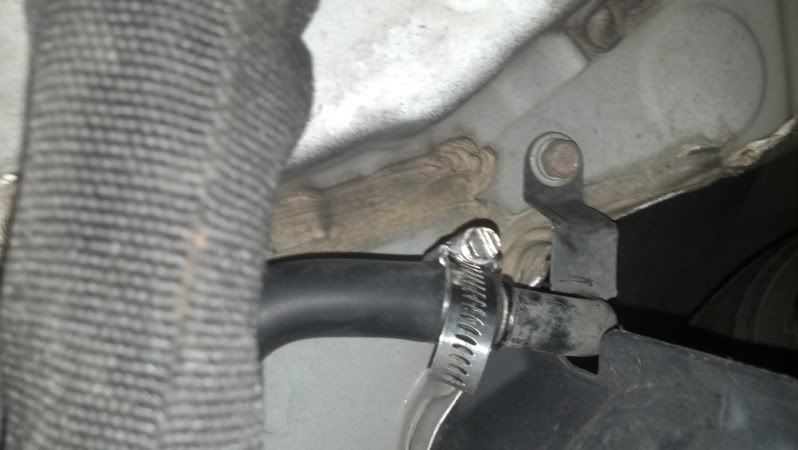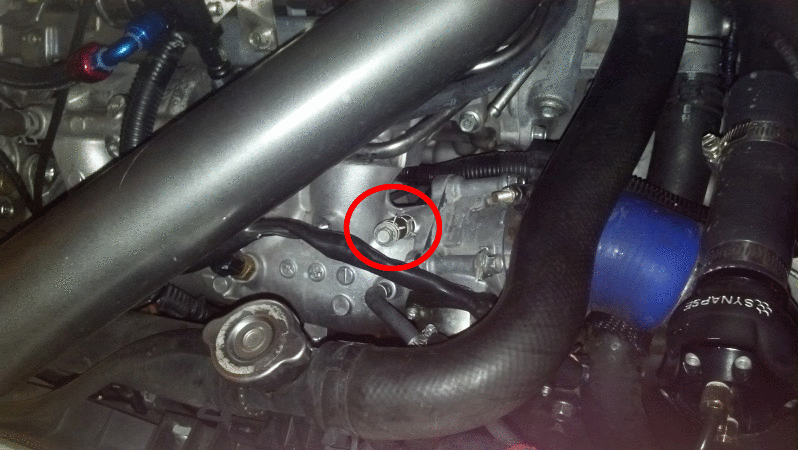As a lot of you know, I am a weight loss junkie, but I also like to experiment with my car to learn new things. The EVAP canister has been taunting me for a while because it just sits there adding weight to my car. Well out of boredom I said screw it and took it off my car.
I knew there would be CEL's that would come up and anyone with the knock CEL mod gets annoyed when the CEL doesnt turn off. So I was determined to get rid of the CEL's. No snipping of any wires is required, so dont do it.
Well your first step is to remove the whole canister. If you dont know where it is, its behind the driver rear tire. It helps if you take off the rear bumper. There is only one set of electrical wires going to the EVAP canister, and that is to control the VENT solenoid (I capitalize it because its important). The canister is pretty easy to get off, 3 bolts hold it on to the car. Once you get those 3 bolts off, It will hang by the tubes. The next step is to remove the tubes from the canister.
The soft large tube going from the canister to a white "plug" that sits in the frame just pulls right out. Do NOT cut this soft large tube at all yet. The small hard tube comes off the same way that the fuel feed line comes off of the fuel rail. Im going to assume you know how to do that. The last tube is a hard large tube that has a fitting on each end of it. If you look at the fitting you will see 2 "buttons" on opposite sides of each other. What you need to do is PUSH hard on those buttons, then the line will come off. Do NOT pull on those buttons cause it will make it a pain in the ass to get that line off.
Now that you have the canister and completely you can unbolt the solenoid from the canister, you need it. The small hard line carries the fuel vapors up to the intake manifold. You can get rid of the whole line (not just the plastic part, but the metal tube that runs parallel to the brake lines up to the front of the car as well). The large hard line you can throw away. As I said before, the large soft tube is the one you need. There are 2 large soft tubes, one on each side of the black cylinder. You need the longer one that has a U shape in it. Get rid of the black cylinder and the short soft line. Cut the large long black tube so that you only have an L shape (you can see in the pic below).
The next part is a little bit of a pain in the ass. You need to get the large soft tube onto the inlet of the vent solenoid (the side with the O-ring on it). Take off the O-ring. I just used some saliva and a flat-head screwdriver to get it on there. Once it is on there you can use a worm gear hose clamp to clamp it on there, or you can use a zip tie like I did. The zip tie was easier for me.
![Image]()
Next you bolt the solenoid to the car. There is 2 white brackets that hang down and work perfectly. Do NOT tighten the bolt all the way yet. Push the other end of the large soft tube onto the fuel tank vent pipe. It is black and runs up the rear wheel well. Its hard to miss as the part of the pipe you need push the large soft tube on to is silver. Secure it on there with a hose clamp.
![Image]()
The reason you need to do all that is the EVAP system will periodically close the solenoid and then measure the fuel tank pressure sensor to test for leaks. So what you need to do is route the EVAP solenoid in line with the vent hose and that should trick the pressure sensor. It gets rid of the evap canister, but keeps all the components talking.
Tighten the bolt holding the solenoid onto the car. Make sure the electrical wire is connected to the solenoid. That part is done. You can now go up to the front of the car and get rid of a few lines up there. There is an EVAP control valve (its a solenoid that looks just like the factory boost control solenoids). Unplug it, then remove all the tubes the solenoid is attached to. There is a small black and red cylinder that you will see, dont throw that away, it is a check valve and you may need it for something else.
Anyways, cut a straight piece of the vacuum line about 2-3" long. That will be your plug for the open tube sticking out of the intake manifold. Find something that fits inside the vacuum line that will plug it up (not your penis :dancebanana . Put a hose clamp around your plug, slide the vacuum line onto the open tube on the intake manifold, and put a hose clamp around that.
. Put a hose clamp around your plug, slide the vacuum line onto the open tube on the intake manifold, and put a hose clamp around that.
![Image]()
You need to plug the solenoid back in otherwise it will throw a CEL. I just took the solenoid completely apart so I can get rid of all the uneeded crap. Then I ziptied it to the wires heading to the MAT sensor.
Now you have gotten rid of the EVAP system and you don't need to disable any codes like with the Evo 8's and 9's :thumbup:
If you have any questions feel free to ask.
I knew there would be CEL's that would come up and anyone with the knock CEL mod gets annoyed when the CEL doesnt turn off. So I was determined to get rid of the CEL's. No snipping of any wires is required, so dont do it.
Well your first step is to remove the whole canister. If you dont know where it is, its behind the driver rear tire. It helps if you take off the rear bumper. There is only one set of electrical wires going to the EVAP canister, and that is to control the VENT solenoid (I capitalize it because its important). The canister is pretty easy to get off, 3 bolts hold it on to the car. Once you get those 3 bolts off, It will hang by the tubes. The next step is to remove the tubes from the canister.
The soft large tube going from the canister to a white "plug" that sits in the frame just pulls right out. Do NOT cut this soft large tube at all yet. The small hard tube comes off the same way that the fuel feed line comes off of the fuel rail. Im going to assume you know how to do that. The last tube is a hard large tube that has a fitting on each end of it. If you look at the fitting you will see 2 "buttons" on opposite sides of each other. What you need to do is PUSH hard on those buttons, then the line will come off. Do NOT pull on those buttons cause it will make it a pain in the ass to get that line off.
Now that you have the canister and completely you can unbolt the solenoid from the canister, you need it. The small hard line carries the fuel vapors up to the intake manifold. You can get rid of the whole line (not just the plastic part, but the metal tube that runs parallel to the brake lines up to the front of the car as well). The large hard line you can throw away. As I said before, the large soft tube is the one you need. There are 2 large soft tubes, one on each side of the black cylinder. You need the longer one that has a U shape in it. Get rid of the black cylinder and the short soft line. Cut the large long black tube so that you only have an L shape (you can see in the pic below).
The next part is a little bit of a pain in the ass. You need to get the large soft tube onto the inlet of the vent solenoid (the side with the O-ring on it). Take off the O-ring. I just used some saliva and a flat-head screwdriver to get it on there. Once it is on there you can use a worm gear hose clamp to clamp it on there, or you can use a zip tie like I did. The zip tie was easier for me.

Next you bolt the solenoid to the car. There is 2 white brackets that hang down and work perfectly. Do NOT tighten the bolt all the way yet. Push the other end of the large soft tube onto the fuel tank vent pipe. It is black and runs up the rear wheel well. Its hard to miss as the part of the pipe you need push the large soft tube on to is silver. Secure it on there with a hose clamp.

The reason you need to do all that is the EVAP system will periodically close the solenoid and then measure the fuel tank pressure sensor to test for leaks. So what you need to do is route the EVAP solenoid in line with the vent hose and that should trick the pressure sensor. It gets rid of the evap canister, but keeps all the components talking.
Tighten the bolt holding the solenoid onto the car. Make sure the electrical wire is connected to the solenoid. That part is done. You can now go up to the front of the car and get rid of a few lines up there. There is an EVAP control valve (its a solenoid that looks just like the factory boost control solenoids). Unplug it, then remove all the tubes the solenoid is attached to. There is a small black and red cylinder that you will see, dont throw that away, it is a check valve and you may need it for something else.
Anyways, cut a straight piece of the vacuum line about 2-3" long. That will be your plug for the open tube sticking out of the intake manifold. Find something that fits inside the vacuum line that will plug it up (not your penis :dancebanana

You need to plug the solenoid back in otherwise it will throw a CEL. I just took the solenoid completely apart so I can get rid of all the uneeded crap. Then I ziptied it to the wires heading to the MAT sensor.
Now you have gotten rid of the EVAP system and you don't need to disable any codes like with the Evo 8's and 9's :thumbup:
If you have any questions feel free to ask.




